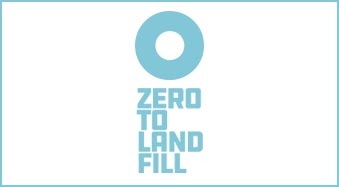
You may have spotted us reference ‘zero to landfill’ throughout our website. That’s because we’re a zero to landfill business, and where possible, we support our clients to do the same.
For many businesses and their clients, environmental responsibility is a growing concern, with businesses pledging several environmental actions that are integral to the way that they do business. Carbon net zero, overstock reductions, supply-chain improvements, and responsible sourcing are all high on the agenda, but so too is what comes next. What can businesses do to minimise their impact once they’ve finished their work? What happens to the waste?
At Printwaste, we specialise in supporting clients’ environmental aspirations, through our responsible waste management practices.
Why zero to landfill?
Landfill involves disposing of waste in a designated area and then burying it. There is no expectation that the waste will be managed or retrieved once buried, and it is expected that it may break down over time but there’s no guarantee, and many materials take thousands of years to degrade naturally. The side effect can be toxic pollution of our land and waterways, as well as unrestricted production of harmful greenhouse gases. It is a problem because it takes up space, degrades the natural environment, and does not ethically or responsibly manage waste. What’s more, it’s a waste of reusable resources that could be repurposed into reusable products, which reduces the requirement for new “virgin” materials to be used during manufacturing.
Zero to Landfill is a commitment to manage waste through alternative, more environmental and sustainable methods, so that materials enter a circular, rather than linear (take-make-waste) lifecycle. Not only does this boost your business’ environmental credentials, but zero to landfill also helps contribute towards a circular economy and avoids waste streams being disposed at landfill sites.
Where does waste go instead?
It depends. Where the waste goes next depends both on the type of waste that is being produced, and on the waste management company that is handling said waste.
First, it depends on the waste stream itself. Some items such as paper, aluminium, cardboard, and glass can be simply and easily recycled and manufactured back into new products, assuming they haven’t been contaminated with other waste. Other items, including those made from multiple materials, those made from hard-to-recycle materials, or those that have been contaminated, such as oil-stained cardboard, need a much more comprehensive and complex approach. This includes but is not limited to recycling of component parts, composting, anaerobic digestion, specialist recycling, incineration, and energy recovery through waste-to-energy.
Second, it depends on the waste management company that handle the waste. Forward-thinking, environmentally committed waste management companies like ours work to specifically minimise environmental impact, which means as much recycling and recovery of materials as possible. Take a look at how we manage our waste streams.
Ultimately, it is best to ask your waste management provider specifically about each item and see where it goes and how it can be traced. At Printwaste, we are committed to practices that manage waste responsibly and ethically for the environment. Asking questions is key, and you should expect your waste management provider to be transparent, offer evidence and discuss your concerns with you.
Can my business pledge zero to landfill? Is it hard?
The hardest part is setting yourself the target in the first place. Once you have decided to become zero to landfill, it’s then a case of identifying what type of waste streams you have, and how else they can be processed. We know it sounds complex, but your waste management provider should be able to help. Take a look at how Printwaste support our clients to become zero to landfill and speak to our team on 01242 588 600 about joining our system to make you zero to landfill.
So there you have it. Zero to landfill is a simple pledge that your business can get working on right away, helping you to meet your environmental commitments, once you have finished doing what you do.



